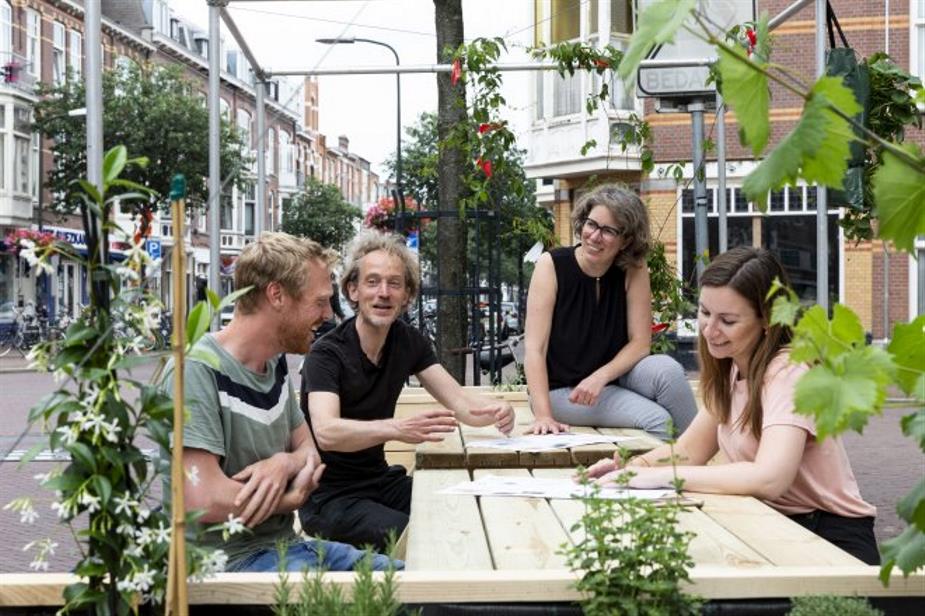Placemaking researched
11 May 2022
Placemaking, the new buzz word around The Hague. But what does it mean? And what is happening in The Hague that we can already refer to as placemaking? Commissioned by the municipality of The Hague, a research team from...

Placemaking, the new buzz word around The Hague. But what does it mean? And what is happening in The Hague that we can already refer to as placemaking? Commissioned by the municipality of The Hague, a research team from Erasmus University, The Hague University of Applied Sciences and Zuijderwijk Stadssociologie looked into this issue. They will present their findings at the Stadsmakersfestival on 13 May.
What is placemaking? Many authors have addressed this question in recent decades. An important similarity in their definitions is that placemaking is about changing a place in such a way that it becomes more enjoyable and interesting for people, and that they also feel more at home. A concise definition is: placemaking is the process of transforming a space into a meaningful place.
Three key concepts keep recurring in placemaking:
- Transformation: placemaking aims to transform space.
- Feeling at home: placemaking gives people a stronger bond with a place and each other.
- Involvement: users of the place are involved in the change, and this alone could strengthen their bond with their surroundings.
Placemaking in The Hague
What is happening in The Hague in the field of placemaking? To answer that question, lead researchers Stefanie Schuddebeurs and Naomi Rommens analysed 38 initiatives in the city. They used, among other things, the typology of Mark Wyckoff, an American scientist in the field of placemaking. Wyckoff distinguishes four types:
Standard placemaking: collective name for large and small placemaking activities that revolve around creating a pleasant public space.
Strategic placemaking: placemaking with an economic impulse as its goal.
Creative placemaking: initiatives that revolve around art in the public space.
Tactical placemaking: small, quick and cheap initiatives to improve the living environment.
Lead researchers Schuddebeurs and Rommens note that all four forms of placemaking of this typology can be found in The Hague. When comparing the four forms of placemaking, a number of points stand out.
- Standard placemaking in The Hague often involves creating more greenery and meeting places in the public space. The initiative usually lies with residents, but housing corporations often play an important role as well. Standard placemaking is similar to tactical placemaking, but the initiatives often last longer and are more structural. An example is the transformation of Cromvlietplan into a neighbourhood park.
- It's noteworthy that strategic placemaking mainly takes place around large, vacant properties and in parts of The Hague that are high on the municipality's policy agenda, such as Zuidwest, the Binckhorst and the area around the NS railway stations. The municipality of The Hague plays a pioneering role in strategic placemaking, the analysis shows. Residents and users don’t always have a clear role. One example of this is the restructuring of the former Ministry of Social Affairs and Employment building.
- Tactical placemaking in The Hague often revolves around creating more green space through smaller and often temporary interventions in a public space. Usually, the initiative comes from residents or civil society organisations. The municipality mainly facilitates the process by removing obstacles and granting permits. Examples of tactical placemaking in The Hague: CarWeide in the Binckhorst, the WijWeibank in the Weimarstraat.
- Creative placemaking in The Hague often means art on walls in public spaces: murals, graffiti or poetry. Civil society organisations and social entrepreneurs often play a role in creating this form of placemaking. Residents are often involved in making the plans, but only occasionally have the lead.
Cooperation and the role of the municipality
Placemaking in The Hague is almost always a collaboration between commercial and non-commercial parties in the city and the municipality. When many parties are involved in such cooperation, it may
bog down the process. The experience of parties in the city with the municipality is mixed. Some initiators have excellent contact with the municipality. Others find the interaction with the municipality difficult, for example because they have to deal with different departments or because internal procedures take a long time. Structural contact could alleviate this.
Community and ownership
An important result of placemaking is that residents and users of the city get a sense of belonging to a particular place. The analysis of The Hague initiatives shows that an important element
of the sense of belonging lies in strengthening the community. If people work together in placemaking, it cuts both ways: people become more attached to the place and to each other. Equally important for that sense of home is ownership. If residents feel involved and have a say in placemaking, they feel more connected to the place in question.
More information
Download the literature review on placemaking here
Download the empirical analysis of The Hague placemaking initiatives here